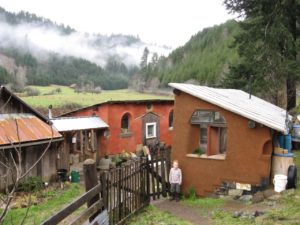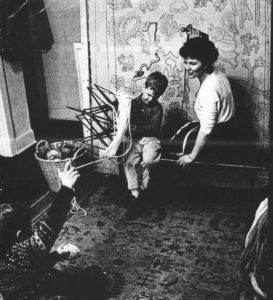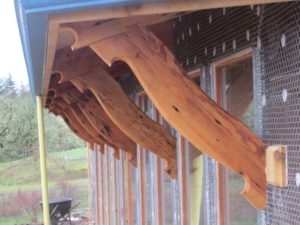Hand Print Press
sprouted in about 2001, on a small, cluttered desk in a small cabin, next to a little cob studio, in a sizeable garden, bounded by creek, forest, and neighbors, human and wild.

I wrote the first book, Build Your Own Earth Oven while trying to find a way to make sculpture and make a living. I had taken an earthen building workshop with Ianto Evans and the Cob Cottage Company in order to learn how to build a cheap house. Ianto also taught us to build a simple wood-fired, earthen oven. Since I had no place to build a house, I started building ovens, a simple kind of sculpture that also made wonderful bread. People saw pictures and wanted their own, so I taught a few workshops, wrote up notes, added pictures and drawings, made a pamphlet, sold 1,000, revised and expanded it, borrowed $5K from my brother, sent the files to the printer — boom! Hand Print Press. (I did build a mud house too — see the photo w/the small boy — now full grown!)

The better part of my education came out of working with mom. I’m in the middle, helping her and my brother organize yarn for the tapestry she’s hooking.
As most do, I started learning how to do stuff from my mother, who learned from (among others) her mom, her granddad, and a teacher named “Miss Doing” (really!), at New York City’s famous “little red schoolhouse.” As part of a long art career that took her around the world, Mom helped develop a hands-on learning program for the Boston Childrens’ Museum visitors’ center. Many Saturdays, I helped her teach paper-making, weaving, rope-winding, etc. When she turned her hand-drawn project sheets into a book, I did the index. Making Things, A Handbook of Creative Discovery sold well for 30 years before Little, Brown let it go out of print. So I re-published it for my kids’ generation. It turned my two-book operation into a real (if small) publishing concern.
In 2010, friends Max and Eva Edleson made the press a two cottage industry. Max re-built the website, and he and Eva wrote and published Build Your Own Barrel Oven, which introduces another variety of wood-fired oven to feed the growing hunger for simple, wood-fired, communal hearths. Max and Eva have two daughters now, a farm, and a business called firespeaking.
Other ideas and projects that came out of the mud include Dig Your Hands in the Dirt, Make a Simple Sundial, Make a Ray Jacobs Rocky Mountain Dulcimer, A Work of Art, and finally, my mom’s 14th book: Satisfy the Image: The Wisdom of Your Dreams and Guided Imagery for Self-Balancing.

Economy
I recognize and appreciate that every purchase comes from a real person. Similarly, every purchase supports, among others, Kim, Perry, Phil, Chris, Jill, Eva, and others who print, store, and ship the books, as well as Jeffrey, Jenna, Sandy, Margot, Michael, et al, at Chelsea Green Books, an employee-owned publisher who also distributes some Hand Print Press titles. And, of course, the folks at Amazon, if you go that route.
The truth of economy (from the Greek word for “home”) asks us to recognize that we don’t really make our own lives but receive them as a gift from a source greater than ourselves (and greater than Jeff Bezos!) But to the extent that I sit in front of a screen in order to earn a few bux, I’m happy to express gratitude for the support it provides for making a home, growing food, raising kids, and working with neighbors. Whether books, stories, or friendship, I offer all in thanks, because wealth is not ours to keep, but to plant, turn over, share.
– Kiko
I am interested in building a mobile oven. Kiko mentions in the preface that more info is posted at hanprintpress.com that includes notes on trailer design by Dan Wing, co-author of The Bread Builders, and owner/builder of a well-traveled mobile oven. However, I cannot find these notes on this site. Can you help me?
Here’s the page about trailers, w/a link to Dan’s trailer notes. I did just hear from someone who sent a photo of an earthen oven that he says has been successfully trailered to numerous different distant locations. More about that soon, I hope.
Hi Kiko,
first thanks a lot for writing the brilliant “build your own earth oven book”! It helped a lot to build two ovens up to now.
I have a question about the “starter” manual in chapter five on page 86 in the 3rd edition. I mixed the starter ingredients three days ago. I wonder why you need to discard 1/4 (1/2) of it each time? Is there a reason or benefit? Wouldn’t it result in the same if I add each time more flour and water?
Thanks
Axel.
Hi, Axel, thanks for the good words. The reason for discarding so much starter has to do with the ratio of organisms to food. If you simply add a bit more food to an already crowded environment, you end up with more competition for limited food; the result is sluggish dough (less respiration) and sour flavors (higher concentrations of acidic waste). By doing it three times in relatively quick succession, you build up a very active population of breeding yeasts. Basically, you’re trying to create the kind of explosion that happens when a small healthy population of critters suddenly encounters “unoccupied” territory. It makes for an unfortunate colonialist/imperialist image, but such are the facts — for a more biological example, look up Charles Manning’s story, in his book 1491, of the sky-darkening populations of passenger pigeons encountered by early Americans. The flocks were not “natural” but an explosion that resulted directly from the massive collapse of the native population w/whom the birds had had to compete for food (some historians estimate that smallpox and other European diseases had reduced the local population by 90% prior to the arrival of the Pilgrims. This left the birds with a HUGE amount of food which led directly to a population explosion. Similarly, if you reduce the population of yeasts and increase the food supply, the remaining yeasts can reproduce more and faster.
I hope this helps!
I understand now. It’s a mathematical and practical issue. You could also always add half of the amount of sourdough you already have in flour and water without discarding. But if you want to have about the same amount of cycles (about 20 for a week) you have to start with a tiny portion of flour and water and increase the amount of flour and water respectively. That makes it of cause very complicated to measure. The benefit would be that you end up with 11 cups of sour dough (instead of 1/2 cup if you always discard 1/2 of it) while investing the same amount of flour and water. I also assume the processes within the dough wound differ if you analyze it in detail.
In a german bread book I found another approach.
1st day:
heat 100g water to 40 degree celsius and mix with rye. Leave it covered for 2 days at room temperature.
3rd day:
add another 100g water (40degree celsius warm) and 100g rye. Leave it covered for 24 hours at room temperature.
day 4:
Add 200g water (40degree celsius) and 200g rye
Leave it covered for 24 hours at room temperature.
day5:
The sourdough is ready and can be baked. Keep 100g as a new starter and use the remaining 700g by adding 300g wheat flour, 350g rye, 20g salt, 20g yeast and 300g water (40 degree).
Hi there!
I’m happy to come a cross with you website, it’s amazing!!
I’m originally from Argentina but living in Australia at the moment.
I wonder if it’s possible for you to ship book to Australia if I put and order as I will like to support Hand print press.
Another question is if there is any chance to find the books in Spanish? there is any plans to translate these books.
In Argentina, as you talk in your website, there is a lot of interest but no many read English.
I remember how complicated was to try take some information from The Hand Sculpted House in my first workshop in Chile. Lucky it’s full of beautiful pictures.
Now after 4 years in Aussie I’m confident to have a go again and enjoy the humor in that book.
ok, I hope to heard from you!!
Jorge Mosqueda
Jorge — first: yes, and yes! We’re happy to ship to Australia, but we do have a distributor down there who should be able to get it to your local bookstore w/out the added shipping expense — the distributor is Ceres books — you should ask your bookstore to order what you want. As for books in Spanish, Build Your Own Earth Oven has just been published in Spanish by Ecohabitar; you can find it here. Thanks for writing!